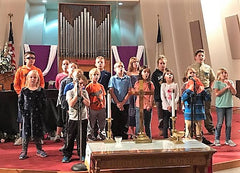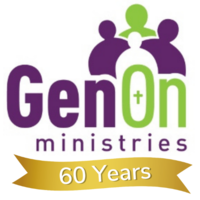
 The church I attend is undergoing renovation and new construction. Among other inconveniences, we were out of the sanctuary for about a year. We worshiped in an elementary school cafeteria for the summer and then in our fellowship hall for the next school year. The fellowship hall is much smaller than the sanctuary so many accommodations were made for special services like Christmas Eve and Easter—and for other uses of the room during the week (like LOGOS Family Time meals). It was a real pain (first world problems, I know) and we are glad to be back in the sanctuary.
The church I attend is undergoing renovation and new construction. Among other inconveniences, we were out of the sanctuary for about a year. We worshiped in an elementary school cafeteria for the summer and then in our fellowship hall for the next school year. The fellowship hall is much smaller than the sanctuary so many accommodations were made for special services like Christmas Eve and Easter—and for other uses of the room during the week (like LOGOS Family Time meals). It was a real pain (first world problems, I know) and we are glad to be back in the sanctuary.
Despite having worshiped in our sanctuary for more than 30 years, my “muscle memory” is still defaulting to the more recent year in fellowship hall. If I’m preparing to lead the children’s message, I picture sitting on the red chair on the colorful rug on the bare wood on the temporary stage. If I’m serving as liturgist, I read over the prayers and scripture as if I’ll be looking out at the rectangular fellowship hall space, not our round sanctuary. I have to “remind” myself of the current space and context. Interesting that a year of new repetitions can undo 30 years of old ones.Muscle memory allows movements to be repeated without much conscious effort (typing, riding a bike or driving a car, playing an instrument). We all learn best by doing. Repeatedly.
How do we help people develop muscle memory for worship? And especially young people who haven’t experienced much repetition in worship yet? They need to be worshiping. Repeatedly.
 We can finger-point as to why they’re not there often (sports, jobs, priorities, rest, boredom) but I believe in raising the bar so that more people take a leadership role in worship that gets them there and engages them. LOGOS has a Worship Arts component. Not Worship, but Worship Arts. It’s time built into the LOGOS evening to learn how to lead in congregational worship and to understand the significance. Choir, drumming, drama, dance, handbells/chimes, banner making, signing, liturgy and prayers. Whatever works for each faith community. All require practice and collaboration, and come with expectations of showing up. Not to perform, but to offer gifts to God and to lead the congregation in worship together.
We can finger-point as to why they’re not there often (sports, jobs, priorities, rest, boredom) but I believe in raising the bar so that more people take a leadership role in worship that gets them there and engages them. LOGOS has a Worship Arts component. Not Worship, but Worship Arts. It’s time built into the LOGOS evening to learn how to lead in congregational worship and to understand the significance. Choir, drumming, drama, dance, handbells/chimes, banner making, signing, liturgy and prayers. Whatever works for each faith community. All require practice and collaboration, and come with expectations of showing up. Not to perform, but to offer gifts to God and to lead the congregation in worship together.
There is a direct correlation between the vitality of worship and the health of a congregation. Worship is at the center of a congregation’s life. Worship is essential to our lives and to our interaction with God who loves us, created us, and continues to be revealed to us. Churches are renewed for all ministries through the corporate worship experience. What can we as church leaders do to encourage more people of all ages to be part of that worship experience? And what can we do repeatedly?
Other GenOn Connect Articles - September-October 2019
One Great Idea: Camp Out LOGOS
Bringing the Relationship Piece to Bible Lessons
Our First Day with Sunday LIFT





weight watchers recipes